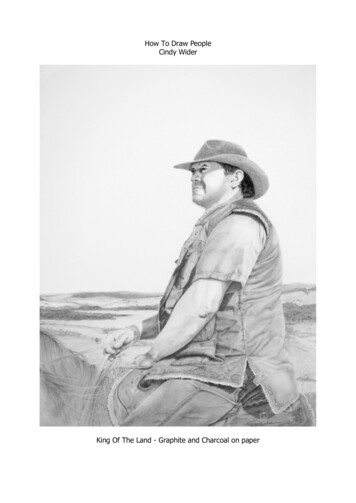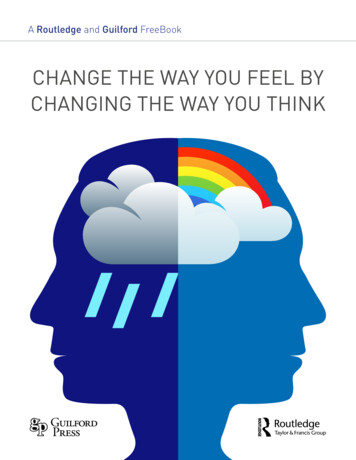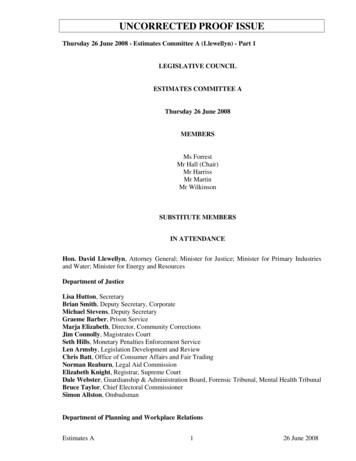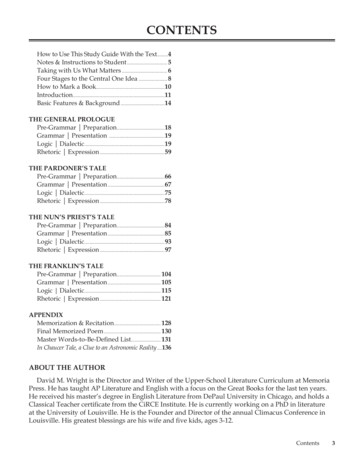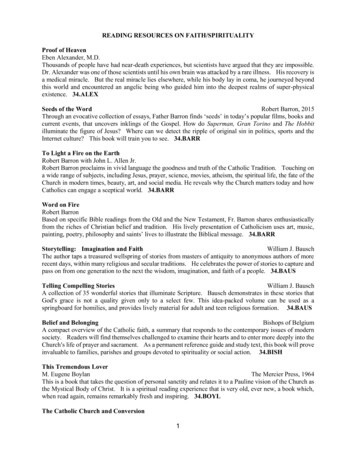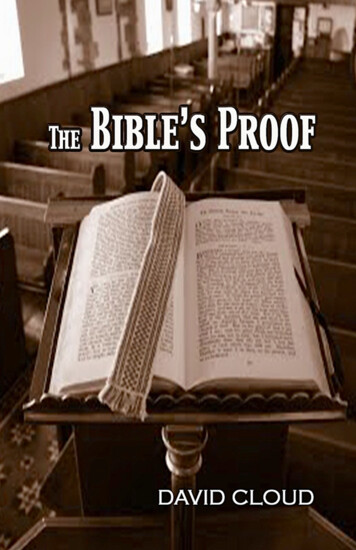
Transcription
1
The Bible’s ProofCopyright 2002 by David CloudISBN 978-1-58318-124-9April 2018This book is published for free distribution in eBook format and isavailable in PDF, MOBI (for Kindle, etc.), and ePUB formats fromthe Way of Life web site. We do not allow distribution of this bookfrom other web sites.Published by Way of Life LiteraturePO Box 610368, Port Huron, MI 48061866-295-4143 (toll free) - fbns@wayoflife.orgwww.wayoflife.orgCanada:Bethel Baptist Church4212 Campbell St. N., London Ont. N6P 1A6519-652-2619 (voice) - 519-652-0056 (fax)info@bethelbaptist.caPrinted in Canada byBethel Baptist Print Ministry2
Table of ContentsIntroduction .5The Person of Jesus Christ .6The Testimony and Resurrection of Jesus Christ .7The Bible’s Unity .24The Character of Its Authors .28Fulfilled Prophecy .29The Bible’s Accuracy .33The Bible’s Candor.38The Bible’s Indestructibility .39The Bibles Appeal .43The Bible’s Doctrine.44Way of Life Literature Publications .463
The Bible’s ProofDavid W. Cloud4
IntroductionThe individual must accept that the Bible is the Word ofGod by faith, for “without faith it is impossible to please him:for he that cometh to God must believe that he is, and that heis a rewarder of them that diligently seek him” (Hebrews11:6).At the same time, Bible faith is not a blind leap into thedark. It is confidence in the Record that God has given, for“faith cometh by hearing, and hearing by the word ofGod” (Romans 10:17). The writers of the Bible explain to usthat they were not delivering cunningly devised fables but adivinely-inspired record based on “many infallibleproofs” (Acts 1:3; 2 Peter 1:16).Following are some of the objective, time-proven reasonswhy we can have complete confidence in the Bible.5
The Person of Jesus ChristOne of these reasons is the Person of Jesus Christ who ispresented in the Bible.Everything about Him is unique: His virgin birth, Hissinless life, His amazing miracles, His wonderful teaching,His brilliant answer to every question, His compassion eventoward those who hated Him, His sacrificial death on thecross for man’s sin, His bodily resurrection, His ascensionback to Heaven, His offer to grant forgiveness of sins andeternal life to any sinner of any nation who believes on Him,His power to change the lives of those who believe.The Jesus presented in the Bible is altogether lovely andunique. He claimed to be the only God and Saviour, and Heproved it by His miracles and by His resurrection from thedead.No novelist could create the Christ of the Bible!Thus one reason we believe the Bible is the Word of God isits central figure, Jesus Christ.6
The Testimony andResurrection of Jesus ChristThe testimony and resurrection of Jesus Christ prove thatthe Bible is the Word of God.Christ taught that the Bible is the infallible Word of God.He quoted from every part of the Old Testament as theWord of God. Some of the Old Testament people and eventsthat Christ referred to are the creation (Mk. 13:19), Adamand Eve (Mt. 19:4-6; Mk. 10:6-7), Cain and Abel (Mt. 23:35;Lk. 11:50-51), Noah and the flood (Mt. 24:37-39), Abraham(Jn. 8:39-40), the destruction of Sodom and Gomorrah (Lk.17:28-29), Lot’s wife turning to salt (Lk. 17:32), Moses andthe burning bush (Mk. 12:26), manna from Heaven (Jn.6:31-32), the brazen serpent in the wilderness (Jn. 3:14-15),Jonah and the whale (Mt. 12:39-41; Lk. 11:29-32), Ninevehrepenting at Jonah’s preaching (Lk. 11:32), Solomon and thequeen of Sheba (Lk. 11:31).Christ often quoted from the book Isaiah and said thehistorical prophet Isaiah wrote it, not an unknown group ofmen as some critics claim. In John 12:38-41, Jesus quotedfrom both major sections of Isaiah and said both werewritten by the same prophet named Isaiah.Of the authority of the Old Testament, Jesus said,“Think not that I am come to destroy the law, or theprophets: I am not come to destroy, but to fulfil. Forverily I say unto you, Till heaven and earth pass, onejot or one tittle shall in no wise pass from the law, tillall be fulfilled” (Mat. 5:17-18).In this passage Jesus taught that the Old Testament isperfect even to the very letters.He further said that “the scripture cannot bebroken” (John 10:35). He was saying that nothing written in7
the Scripture can be set aside or ignored. It is authoritative toevery detail; it is a chain with no weak links.Jesus claimed to be the Son of God, and His resurrectiongives infallible witness to this claim.The Bible says there are “many infallible proofs” ofChrist’s resurrection (Acts 1:3). In fact, it is one of the bestdocumented events of ancient history. Bible-believingChristianity is not blind religious faith!Jesus and the Bible and Christianity rise or fall on Christ’sresurrection!The Bible’s accounts of Jesus claim to be historical,eyewitness accounts (Luke 1:1-4; 2 Peter 1:15-16; 1 John 1:3).If the accounts are not historically accurate, then they canrightly be rejected.Christ staked His authority on the resurrection (at leastseven times He said He would die and rise from the dead -Matthew 16:11; 17:9, 22-23; 20:18-19; 26:32; Luke 9:22-27;John 2:18-22).Paul said that the Christian faith depends on Christ’sresurrection (1 Corinthians 15:14-17).Four great evidences for the resurrection of Christ1. The character of the Gospel accountsThe Gospel accounts themselves give every evidence thatthey were written by eyewitnesses who believed what theywrote and who were speaking the truth withoutembellishment and myth-making.Consider the details of the accounts.“John’s Gospel is characterized throughout by thepersonal touch; it has all the marks of the evidencenot only of an eyewitness, but of a careful observer .The running of the disciples, the order of their arrivalat the sepulchre and their entry, the fact that Johnfirst stooped down and looking through the lowdoorway saw the linen clothes lying, while Peter,8
more bold, was the first to enter . the description ofthe position of the linen clothes and the napkin .this can surely be nothing else than the description ofone who actually saw, upon whose memory the sceneis still impressed, to whom the sight of the emptygrave and the relinquished grave-clothes was acritical point in faith and life” (E. Day, On theEvidence of the Resurrection, pp. 16-17).Consider the candor of the accounts. When someoneinvents a religion, he glorifies its leaders, but the Gospelspaint the founders of Christianity as very weak (e.g., Peterhaving to be rebuked by Christ as Satan--Mat. 16:23; Peterdenying Christ thrice; the disciples fleeing and hiding;Thomas and others doubting Christ even after He appears tothem).Further, if men had made up the accounts of Christ’sresurrection, they would not have said that the women werethe first to believe. In that day women had no authority inthe eyes of society. They could not even testify in a court oflaw in those days, except on rare occasions (J.P. Moreland,Scaling the Secular City, p. 168). The account of the womenbelieving first is not something that would have been writtenunless it actually happened and the writers were committedwholeheartedly to recording the truth and nothing but thetruth. This striking candor is powerful evidence that theGospels are true, unvarnished accounts.2. The empty tombThat the tomb of Jesus was empty is proven by two facts:First, the Jewish leaders had to invent the lie that thedisciples had stolen His body (Mat. 28:11-15). If Jesus’ bodywas located anywhere, they would have searched it out andproduced it.Second, just weeks after the crucifixion, only a stone’sthrow from the empty tomb itself, Peter publicly proclaimedthe resurrection and 3,000 believed, followed a little later by“a great company of priests” and “a great number” more9
(Acts 2:37-42; 6:7; 11:21). If anyone could have produced thebody or come up with a reasonable account for it beingmissing, they would have!The following are theories that have been proposed toaccount for the empty tomb:“The field of biblical criticism resembles a vastgraveyard filled with the skeletons of discardedtheories devised by highly imaginative skeptics. .One might think that so many repeated failures .would lead the opposition to abandon their efforts,but not so. They continue unabated, and men are stillwracking their brains, working their imaginationsovertime, and parading a vast amount of eruditionand ingenuity in their, to us, futile attempts todestroy the impregnable rock of historical evidenceon which the Christian faith in the resurrectionstands proud and unshaken” (John Lilly).Some say Jesus just swooned and recovered in the coolof the tomb.This is refuted by the fact that the professional soldiers hadascertained that he was dead (John 19:31-34).Further, how could a near-dead man remove the heavystone and convince his followers that he had risen from thedead? Consider what Christ endured: severe beating; nailspiercing His hands and feet; spear piercing His side (John19:34); great loss of blood and bodily fluids.Some say that the women went to the wrong tomb.In The Historical Evidence for the Resurrection of JesusChrist, Kirsopp Lake claimed that the women were confusedin the dark and went to the wrong tomb. Not only is thiscontrary to what the Gospel accounts say, it makes no sensewhatsoever. If the women had gone to the wrong tomb andreported that Christ had risen based on that mistake, thematter would soon have been cleared up. First, the discipleswere not stupid. They would not have given their lives for the10
testimony of a few geographically-challenged women. Theywould have checked out the story thoroughly and wouldhave come to the truth of the matter. Further, the Jewishleaders would have made certain that the matter was clearedup by producing the right tomb, and the body!Some say the disciples were hallucinating.If they were hallucinating, it was a mass hallucination,because Paul said that the resurrected Christ was seen byabove 500 people at once (1 Cor. 15:5-8)!When Paul wrote the epistle of 1 Corinthians, most ofthese eyewitnesses were still alive. Paul was not writing aboutthings that had happened long ago.Josh McDowell observes: “Let’s take the more than 500witnesses who saw Jesus alive after His death and burial, andplace them in a courtroom. Do you realize that if each ofthose 500 people were to testify for only six minutes,including cross-examination, you would have an amazing 50hours of firsthand testimony? Add to this the testimony ofmany other eyewitnesses and you would well have thelargest and most lopsided trial in history” (“Evidence for theResurrection”).It has been rightly said that “this theory makes Christ afraud and his disciples near idiots.”“Somehow the rugged fisherman Peter and hisbrother Andrew, the characteristically doubtingThomas, the seasoned and not too sensitive taxgatherer, Matthew, the rather dull Philip, intenselyloyal but a little slow of apprehension, do not fiteasily into the conditions required for an absolutelyunshakable collective hallucination. And if it is notboth collective and unshakable it is of no use to us.The terrors and the persecutions these menultimately had to face and did face unflinchingly, donot admit of a halfhearted adhesion secretlyhoneycombed with doubt” (Morison).11
Some say they saw someone disguised as Jesus (e.g.,Hugh Schonfield, The Passover Plot)This is too ridiculous to waste time refuting. Having spentthree years with Jesus, wouldn’t the disciples know Him?They might be confused for a moment or even a short while,but eventually they would recognize that the individual wasan impostor.Some say the body was stolen.This was the story invented by the Jewish leaders. Theypaid the guards to lie and to say that the disciples stole Jesus’body (Mat. 28:11-15). This is an impossible story.First, if they were asleep how could they know whathappened to the body, or if stolen, who stole it?Second, sleeping on guard duty brought the death penaltyin that day. That one of the guards might fall asleep isperhaps conceivable, but that all of them would fall asleep isnot. As Richard Dickinson observes: “That without anexception all should have fallen asleep when they werestationed there for so extraordinary a purpose, to see thatthat body was not stolen, lest it should be said that thecrucified Jesus had risen from the dead, may be possible; butit is not credible: especially when it is considered that theseguards were subjected to the severest discipline in the world.It was death for a Roman sentinel to sleep on his post. Yetthese guards were not executed; nor were they deemedculpable even by the rulers, woefully chagrined andexasperated as they must have been by the failure of theirplan for securing the body” (The Resurrection of Jesus ChristHistorically and Logically Viewed, 1865).(That the guard was a Roman guard is clear from thepassage. The Greek word for “watch” in Matthew 27:65,koustodia, is the word for a Roman sentry. A.T. Robertsonsays that “ye have a watch” is present imperative and refers to“a guard of Roman soldiers, not mere temple police.” InMatthew 28:12 they are called “soldiers,” which would not be12
the case if they were temple police. Further, Matthew 28:14indicates that they were Roman guards, because they wereafraid of what Pilate would do if he heard of the matter.)Third, by their actions it is evident that the Jewish leadersdidn’t believe their own story. They didn’t call the disciplesto examine them when they found out the body was missing,and they made no effort to find the body. John Chrysostom,in the fourth century, observed that the story of the stealingof the body actually establishes the resurrection. “For this isthe language of men confessing, that the body was not there.When therefore they confess the body was not there, but thestealing is shown to be false and incredible--by theirwatching by it, and by the seals, and by the timidity of thedisciples--the proof of the resurrection even hence appearsincontrovertible” (The New Evidence that Demands aVerdict, p. 264).Further, who could have stolen Christ’s body?The Jews certainly didn’t steal it, because they wanted toprove that He did not rise.The Roman government certainly didn’t steal it, becausethe government sealed the tomb and had no reason to steal itand thus allow the Christians to say He had risen.Joseph of Arimathea certainly didn’t steal it. He was Jesus’disciple and had no motive to steal His body. Further, hecouldn’t have stolen it alone, because he couldn’t haveremoved the great stone, so he would have needed help, anddoubtless someone would have reported the deed sooner orlater.The disciples certainly didn’t steal it. First, they were hidingin fear for their lives. Second, they had no opportunity,because the tomb was sealed and guarded. Third, they had noleader who could have envisioned and accomplished such athing. Their leader, Peter, was a broken man at that pointand had given up his discipleship to Jesus to go back tofishing (John 21:3). Fourth, they would have been fools tohave suffered and died for a lie! The disciples didn’t suffer for13
what others had seen, such as Muslims who die for theKoran, but they died for what they had professedly seenthemselves (Acts 4:18-20). Fifth, it would have beenimpossible for such a large number of people to have kept thesecret hidden. “Even if it had been possible, and the disciplesthe men to do it, the subsequent history of Christianitywould have been different. Sooner or later, someone whoknew the facts would have been unable to keep themhidden” (Frank Morison, Who Moved the Stone?). Sixth, agreat moral religion like we find in the New Testament,which exalts truth and honesty, could not have been foundedupon a despicable deception.“It is the complete failure of anyone to produce theremains, or to point to any tomb, official orotherwise, in which they were said to lie, and thisultimately destroys every theory based on the humanremoval of the body” (Morison).We must not forget exactly what the early Christianssuffered for their testimony that Christ had risen from thedead.They were denounced by family and friends, hated by andconsidered the enemies of society, tortured, kept imprisonedfor years in dark, rat-infested cells. Their propertyconfiscated; they were crucified, burned alive, torn apart bywild beasts, chopped into pieces, roasted on racks; theirtongues were torn out and their eyes put out. The also had toendure the torture and death of beloved family members.“Their master had recently perished as a malefactor,by the sentence of a public tribunal. His religionsought to overthrow the religions of the whole world.The laws of every country were against the teachingsof His disciples. The interests and passions of all therulers and great men in the world were against them.The fashion of the world was against them.Propagating this new faith, even in the mostinoffensive and peaceful manner, they could expect14
nothing but contempt, opposition, revilings, bitterpersecutions, stripes, imprisonments, torments, andcruel deaths. Yet this faith they zealously didpropagate; and all these miseries they enduredundismayed, nay, rejoicing. As one after another wasput to a miserable death, the survivors onlyprosecuted their work with increased vigor andresolution. The annals of military warfare affordscarcely an example of the like heroic constancy,patience, and unblenching courage. They had everypossible motive to review carefully the grounds oftheir faith, and the evidences of the great facts andtruths which they asserted; and these motives werepressed upon their attention with the mostmelancholy and terrific frequency. It was thereforeimpossible that they could have persisted inaffirming the truths they have narrated, had not Jesusactually risen from the dead, and had they not knownthis fact as certainly as they knew any other fact. . Ifthen their testimony was not true, there was nopossible motive for its fabrication” (Simon Greenleaf,An Examination of the Testimony of the FourEvangelists by the Rules of Evidence Administered inthe Courts of Justice, 1846).Some say the disciples made up the accounts.This would mean that they all suffered and died on thebasis of a lie, which makes no sense. It is one thing to found areligion or cult when you will benefit from it materially, butit is quite another thing to invent one if you will only sufferfor it.Further, as we have already noted, it is obvious from theirvery nature that the Gospel accounts were not made up. Theyare filled with lifelike detail and they are too candid to bemythical.Some say Jesus rose spiritually but not bodily.Jesus specifically refuted this by eating and letting thedisciples touch Him (Luke 24:37-43).15
Frank Morison set out to discredit the Gospel accounts ofChrist’s resurrection, and instead he concluded that the onlything that can satisfy the historical facts is that Jesus actuallydid rise from the dead.We agree and we find it much easier to believe in Christ’sresurrection, than to believe in the attempts to discredit it.“The simple faith of the Christian who believes in theresurrection is nothing compared to the credulity ofthe skeptic who will accept the wildest and mostimprobable romances rather than admit the plainwitness of historical certainties. The difficulties ofbelief may be great; the absurdities of unbelief aregreater” (George Hanson, The Resurrection and theLife).The reason why there are so many theories that attempt todiscredit the Gospel accounts is that men are willfully blindsinners who do not want to submit to God (2 Corinthians4:4).Further, the unbelief of “Christian preachers” such asKirsopp Lake was prophesied in Scripture.“But there were false prophets also among the people,even as there shall be false teachers among you, whoprivily shall bring in damnable heresies, evendenying the Lord that bought them, and bring uponthemselves swift destruction. And many shall followtheir pernicious ways; by reason of whom the way oftruth shall be evil spoken of” (2 Peter 2:1-2).3. The eyewitnessesPaul used the eyewitnesses of the resurrection as anirrefutable evidence (1 Cor. 15:5-8). He says the risen Christwas seen of more than 500 brethren at one time.And it is not only the Gospels and the New TestamentEpistles that give eyewitness testimony of Christ’sresurrection.16
Clement of Rome (d. 99) was taught directly by some ofthe apostles and we have his letter to the church at Corinth.Polycarp (69-159) personally knew the apostle John andother believers who were eyewitnesses of Jesus’ resurrection,and we have his letter to the church at Philippi dating toabout AD 115.4. The changed lives“Then the same day at evening, being the first day ofthe week, when the doors were shut where THEDISCIPLES WERE ASSEMBLED FOR FEAR OFTHE JEWS, came Jesus and stood in the midst, andsaith unto them, Peace be unto you” (John 20:19).Something dramatic happened to turn the disciples fromfear to courage.Consider the testimony of PeterAfter denying Christ the night of His arrest, Peter was adefeated man. He determined to go back to fishing (John21:3). A few weeks later, the man who had denounced Christbefore a handful of Jews on the eve of Christ’s crucifixion,preached boldly to a multitude of them on the day ofPentecost and 3,000 were converted. What could havewrought such a mighty change other than that he hadbecome convinced that Jesus had risen from the dead?Consider the testimony of James, Jesus’ half brotherJesus’ brothers were opposed to Him during His lifetime(John 7:7), but after Jesus rose from the dead, James believedand became a leader in the church at Jerusalem (Acts 12:17;15:13; 21:18; Gal. 1:19). James’ conversion was prompted byChrist’s resurrection appearance to him (1 Cor. 15:7).Consider the testimony of PaulWhat converted Paul from being a bitter enemy of Christto being one of His most zealous followers? From an earthlyperspective, Paul had absolutely nothing to gain andeverything to lose by following Christ. He admitted that he17
had “profited in the Jews’ religion above many” (Gal. 1:14).Paul testified that it was the resurrected Christ whoconvinced him (Acts 22:3-21).As a zealous Pharisee and leader of Christ’s enemiesamong the Jews, Paul was in a position to know all about thestory about the disciples stealing the body. Had he thoughtthat Jesus’ dead body actually lay hidden somewhere, hewould never have believed in the resurrection. It is obviousthat even he did not give any credence to this story.Consider the testimony of lawyers and judgesThomas Sherlock wasn’t a lawyer but he was trained in law.He was a Cambridge-educated theologian in the Church ofEngland, and he wrote a classic book that examines theevidence for the resurrection of Christ from a courtroomperspective. It is titled The Trial of the Witnesses of theResurrection of Jesus (1729). Sherlock wrote the book to rebutDeist Thomas Woolston’s skeptical book Discourses of theMiracles of Jesus Christ.“Within the framework of a courtroom proceedingin which the Apostles are on trial for faking theResurrection, Sherlock pits Woolston’s ownarguments against his own powerful defense of the‘accused.’ Applying the logic and reason of the law tothe Bible, this is a provocative and originalinterpretation of the story of Jesus' life anddeath” (Bookkilden.no).Simon Greenleaf, Royall Professor of Law at HarvardUniversity, was one of the most celebrated legal minds ofAmerica. He was the author of the three-volume A Treatiseon the Law of Evidence, which is “still considered the greatestsingle authority on evidence in the entire literature on legalprocedure” (Wilbur Smith, Therefore Stand, p. 463). After athorough examination, Greenleaf concluded that Jesus didrise from the dead. In 1846 he published An Examination of18
the Testimony of the Four Evangelists by the Rules of EvidenceAdministered in the Courts of Justice.“All that Christianity asks of men is, that they wouldbe consistent with themselves; that they would treatits evidences as they treat the evidence of otherthings; and that they would try and judge its actorsand witnesses, as they deal with their fellow men,when testifying to human affairs and actions, inhuman tribunals. Let the witnesses [to theResurrection] be compared with themselves, witheach other, and with surrounding facts andcircumstances; and let their testimony be sifted, as ifit were given in a court of justice, on the side of theadverse party, the witness being subjected to arigorous cross-examination. The result, it isconfidently believed, will be an undoubtingconviction of their integrity, ability and truth” (AnExamination of the Testimony of the FourEvangelists).Lord Darling, former Chief Justice of England, said:“The crux of the problem of whether Jesus was, orwas not, what He proclaimed Himself to be, mustsurely depend upon the truth or otherwise of theresurrection. On that greatest point we are notmerely asked to have faith. In its favour as livingtruth there exists such overwhelming evidence,positive and negative, factual and circumstantial, thatno intelligent jury in the world could fail to bring in averdict that the resurrection story is truth” (citedfrom Michael Green, Man Alive, 1969, p. 54).Lord Caldecote, Lord Chief Justice of England, testifiedthat,“[A]n overwhelming case for the Resurrection couldbe made merely as a matter of strict evidence. .[Christ’s] Resurrection has led me as often as I havetried to examine the evidence to believe it as a fact19
beyond dispute” (cited by Irwin Linton, A LawyerExamines the Bible, p. xxiv, xxv).Edmund Hatch Bennett was dean of the Boston UniversitySchool of Law for more than 20 years, as well as a judge inthe Massachusetts Probate Court. In 1899 he wrote The FourGospels from a Lawyer’s Standpoint. He begins by saying:“. this paper is the result of an effort, on my ownpart, to ascertain whether or not, independently ofthe exercise of a devout Christian faith,independently of any appeal to our religioussentiments, the truth of the story told in the fourGospels could be satisfactorily established by a merereasoning process, and by applying the sameprinciples and the same tests to the Gospel narrativesthat we observe in determining the truth or falsity ofany other documents, or any other historicalaccounts.”Bennett makes the following argument:“These stories began to be published not long afterthe alleged crucifixion. Many persons were thenliving who could have easily refuted the statements ofthe evangelists had they been untrue. The enemies ofJesus were still alive and active. The Scribe and thePharisee, the Priest and the Levite, still smartedunder his repeated denunciations. They had thedisposition, the opportunity, and the incentive todeny the story of the miraculous birth, the spotlesslife, the marvelous works, the sublime death, theastounding resurrection, and the glorious ascensionof our Lord, had the then published description ofthese events been totally fabulous. But so far as weknow, no person then living ever uttered a protestagainst these accounts, and for two thousand yearsthey have been received and treated as veritablehistory.”20
Irwin Linton, a Washington D.C. lawyer who argued casesbefore the Supreme Court, published A Lawyer Examines theBible: An introduction to Christian Evidences in 1929.“Lawyers regularly sift through testimonies in orderto separate falsehood from truth. A unique feature ofthis book is its weighing of testimonies in support ofthe Bible. Linton points out that lawyers askwitnesses seemingly trivial details because, while themain outlines of false testimony can be agreed uponin advance, the innumerable trifling details cannot.Apparent contradictions between the Resurrectionaccounts prove the absence of collusion, and the factthat they can be resolved adds credibility to thetestimonies. So, far from being fatal, the apparentcontradictions between the Gospel accounts of theResurrection turn out to be support for theauthenticity of the event. On this, Linton cites Paley:‘The existence of the difficulty proves the want orabsence of that caution which usually accomplishesthe consciousness of fraud; and the solution provesthat it is not the collusion of fortuitous propositionswhich we have to deal with, but that a thread of truthwinds through the whole, which preserved everycircumstance in its place’” (A Lawyer Examines theBible, 1949 edition, p. 75).J.N.D. Anderson (Sir Norman Anderson) is dean of thefaculty of law in the University of London and director of theInstitute of Advanced Legal Studies. He wrote Christianitythe Witness of History: A Lawyer’s Approach (1969).“The most radical theory of all is to dismiss the wholestory as deliberate invention. But there is scarcely asingle intelligent critic who would go so far. Theadverse evidence is overwhelming. Think, first, of thenumber of witnesses. Paul tells us that in 56 A.D. themajority of some 500 original witnesses were stillalive; and we must remember that most of the earlyrecords went out, as it were, with the collective21
authority of the primitive Church. Think, too, of thecharacter of the witnesses. Not only did they give theworld the highest moral and ethical teaching it hasever known, but they lived it out, as even theiropponents were forced to admit. Again, think of thephenomenal change which these men underwentbecause of this alleged invention. Is it conceivable
The Bible’s Proof David W. Cloud 4. Introduction . back to Heaven, His offer to grant forgiveness of sins and . Christ often quoted from the book Isaiah and said the historical prophet Isaiah wrote it
